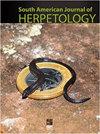干扰区两种热带壁虎觅食生物学比较
IF 0.7
4区 生物学
Q4 ZOOLOGY
引用次数: 1
摘要
摘要传统的蜥蜴觅食模式二分法一直是伏击捕食者和广泛捕食者的二分法。每种模式都有自己的一套互补特征,包括代谢率、感觉能力以及捕食者和猎物种类。虽然蜥蜴家族的觅食模式通常是一致的,但很少有研究比较同一分支中一个物种是夜行性的而另一个是昼行性的同域成员的觅食模式。一种引进的夜间活动的家壁虎——frenatus和一种本地的日间活动的家壁虎——Gonatodes albogularis生活在哥斯达黎加受干扰的栖息地。利用传统的基于运动的指标,即每分钟移动数(MPM)和移动时间百分比(PTM),我们发现在活动高峰时段,舌蟾的移动数(MPM = 0.47)和移动时间(PTM = 0.74%)明显少于白纹大腹蛇(MPM = 0.97, PTM = 3.94%)。造成这种活动水平差异的一个原因可能是人工照明对吸引节肢动物到frenatus觅食区有有益的影响。本文章由计算机程序翻译,如有差异,请以英文原文为准。
A Comparison of the Foraging Biology of Two Tropical Gecko Species in Disturbed Areas
Abstract. The traditional foraging mode dichotomy in lizards has been one of ambush predators vs. wide ranging predators. Each mode has been associated with its own suite of other complementary characteristics, including metabolic rates, sensory capacities, as well as predator and prey species. While foraging mode within lizard families is often consistent, few studies have compared the foraging modes of sympatric members of a clade in which one species is nocturnal and the other diurnal. Hemidactylus frenatus, an introduced, nocturnal house gecko, and Gonatodes albogularis, a native, diurnal species, inhabit disturbed habitats in Costa Rica. Using traditional movement-based indices, moves per minute (MPM) and percent time spent moving (PTM), we found H. frenatus to move significantly less (MPM = 0.47) and spend significantly less time moving (PTM = 0.74%) than G. albogularis (MPM = 0.97, PTM = 3.94%) during peak activity times. One reason for this difference in activity level could be the beneficial effects of artificial lighting in attracting arthropods to H. frenatus foraging areas.
求助全文
通过发布文献求助,成功后即可免费获取论文全文。
去求助
来源期刊
CiteScore
1.50
自引率
0.00%
发文量
10
期刊介绍:
The South American Journal of Herpetology (SAJH) is an international journal published by the Brazilian Society of Herpetology that aims to provide an effective medium of communication for the international herpetological community. SAJH publishes peer-reviewed original contributions on all subjects related to the biology of amphibians and reptiles, including descriptive, comparative, inferential, and experimental studies and taxa from anywhere in the world, as well as theoretical studies that explore principles and methods.

 求助内容:
求助内容: 应助结果提醒方式:
应助结果提醒方式:


